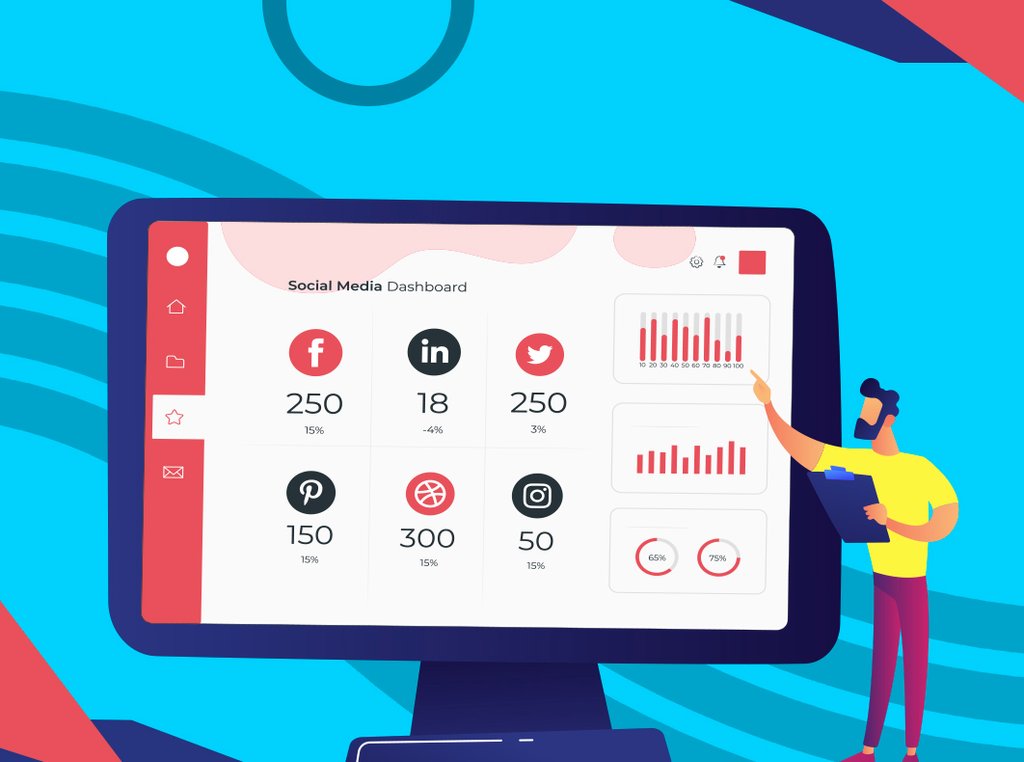Best social media analytics tools and tracking for business

Choosing social media analytics tools for your business and marketing needs is an obstacle course marathon on Guantanamo Bay. Thousands of programs, services, plugins that use different technologies, approaches, logic — and all this needs to be combined according to the needs of your business, without spending extra money and time.
Remember that effective analytics is built on complete data, and its tracked indicator is related to both the business need and the area of responsibility of the company's employees. This article will be helpful for those who are starting to automate marketing processes and want to minimise the time spent.
Table of contents:
Defining social media data
Social media data (or social data for short) is information about the activity of individuals on social media — for example, your prospects and customers. Social media data allows you to track how people interact with your content or social media channels. These are numbers, percentages, and statistics, through which you can conclude the effectiveness of your social media strategy.
Social media is best viewed as a source of raw data that includes (but is not limited to) the following metrics:
- Promotions.
- Likes.
- Conversions.
- Comments.
- Mentions.
- Impressions.
And most importantly, clicks — click metadata is critical to understanding what potential customers are interested in.
What is social media tracking
Social media tracking is an integral part of media analytics.
Social media tracking is tracking intermediate indicators of an advertising campaign. It is used both to get an idea of the quality and behaviour of the target audience and improve the efficiency of budget allocation between advertising channels.
For example, there’s an advertising campaign for a pizzeria. Several channels are used for programmatic purchases — banners, advertising in social media, networks, advertising on mobile devices, and the pizzeria’s mobile application.
The product of the advertising campaign is the action "Pizza in 30 minutes or for free!"
Objectives are increasing calls and checking total. With the help of advertising tracking, you can track which channels were the most profitable, which was the most popular, the average check for which channel is higher, and many other important indicators.
Why social media analytics are vital for business
Before we dive into the topic, let's take a closer look at why social media analytics is important to a business.
Tracking Efficiency
You can track the effectiveness and speed of the marketing team. The data obtained will allow you to know if they’re moving in the right direction.
A good social media analytics tool will allow you to measure KPIs for community management, such as response times and audience sentiment.
Social media management is not an easy task. One wrong step can lead to a drop in performance, which means a disaster.
Micromanagement is the past. With the help of analytical solutions, marketing teams can draw up reports correctly, and CMOs can see essential data on profit and loss, determining development trends.
Measuring KPI
KPI indicators are selected individually for each project. Here we list only the most popular ones:
- Traffic.
- Conversion to purchases.
- Visibility in search (position).
- Bounce rate.
- Average cost; the number of purchases per customer.
- Points of exit of visitors (baskets, registration forms, etc.)
- CPC, CPO.
- ROI.
Today KPI is becoming an important and, most importantly, an effective method of monitoring the effectiveness of an advertising campaign, and the tasks of the system should be focused on the overall business strategy. Using KPIs in reports takes customer interaction to a new level and helps to assess each specialist’s contribution to the overall process.
The practice of using KPIs in the field of Internet marketing also shows:
- It’s useless to estimate conversions without considering profit.
- It's useless to chase positions and traffic without taking into account conversions.
- All indicators must be measurable.
- The indicators should be monitored on an ongoing basis.
- Indicators help to assess the effectiveness of a specialist's work.
By analysing the data, you will understand what is successful in your chosen strategy and what is not. You will be able to make any effective adjustments.
Clear views also allow CMOs or anyone in the organisation to quickly and easily see the most important metrics and measure marketing performance very quickly and easily so that everyone is up-to-date.
How you can use social media analytics for business
Audience analytics
Knowing your business’s target audience will help you create an effective marketing strategy for good customer service.
Unlike in the past, when audience data was scattered across separate platforms on the Internet, there are analytical tools powered by artificial intelligence technologies. They allow you to analyse customer behaviour in a couple of clicks.
As a result, you can see at a glance who your target audience is, the ideal customer, and ensure that their broader marketing strategy is aligned with the characteristics, interests, and behaviour of the buyers.

Remember, the more personalised your ad is, the lower the cost. Knowing your audience is the key to showing your ads more often and lowering your cost per click.
Performance analytics
Determining your performance will help you understand the moments where your strategy works and justifies the investment and where it needs to be changed.
This may be due to the pandemic, but according to data from Socialbakers, digital spending on Facebook and Instagram increased 56.2% YoY in 2020.

Key performance indicators allow you to track:
- Interaction quality helps you understand whether your audience is attracted to the content you publish.
- You will be able to find out how much of your community is responding to your published content.
- Based on the data received, you can increase the number of clicks on your posts.
- The growth rate of the number of subscribers will also allow us to assess the quality of the team's work.
Competitive analytics
A competitive context allows you to understand your performance metrics. This requires competitive analytics.
One way to gauge the performance of your business and understand what changes you need to make is through benchmarking.
By comparing your social media business performance metrics with your competitors, you can get a sense of how successful your performance and ROI are about the market as a whole.
Comparisons can be made with one or several companies. At the same time, competitive analysis should be carried out regularly. This will allow you to understand their strategy and ultimately win.
Remember, if you aren’t doing competitive analysis, then perhaps your competitors are doing it.
Paid social media analytics
According to data from Socialbakers and Gartner, it became clear that spending on digital technologies in 2020 increased by 60%.
A lot of money is spent on promotion. Therefore, knowing what content works for every dollar spent is beneficial.
Some companies use AI-powered tools that accurately predict what content should be curated for the best results — and early adopters see great results.
These indicators will perfectly reflect the effectiveness of your investments:
- Number of ads.
- Total spend.
- Clicks.
- Click-through rate.
- Cost per click.
- Cost per engagement.
- Cost per action.
- Cost per purchase.
- Campaign ROI.
It will be equally effective to compare your expenses with those of your competitors. You will understand if your budget is sufficient or find points in your advertising strategy for optimisation. Simultaneously, monitoring should be carried out regularly and often — monthly reports will not be enough.

This will help you identify important trends — for example, you are overpaying for clicks — and then adjust your budget accordingly.
Influencer analytics
Collaborating with influencers is always costly. Therefore, you need to make sure that you are spending your budget correctly. To do this, you need to track key performance indicators. This will help you make the most of the power of influencers.

Influencers' performance can also be analysed. Pay attention to the following key metrics:
- Interactions per 1,000 subscribers can help you figure out if they're getting attention effectively.
- The size of the audience covered.
- The number of posts to see how active they are.
- Brands the influencer has worked with in the past.
Sentiment analysis of your profiles and ad campaigns
Measuring sentiment also needs to be carried out. This can lead to negative customer perception of the brand.
This is why it’s so important to keep track of the ups and downs in sentiment — especially with an AI-powered social analytics tool.
Analytics will help support the growth in fan base, engagement and engagement levels, and conversions. You will also be able to make the right decisions in content creation and content strategy development.
Sentiment analysis is instrumental when you need to evaluate the effectiveness of several advertising campaigns at once.
Remember, it all starts with your audience, and sentiment analysis is the most fundamental social media analysis you can do. If the client has a negative image of your brand, it is tough to change it.
Best tool to track your key performance insights
If you need a social media analytics tool for business, check out Postoplan. It is a smart, automated social media and messenger marketing platform that allows you to create, schedule, and promote content.
With Postoplan, you can save up to 90% on social media marketing and drive up to 40% customer growth through increased reach.
Postoplan advantages:
- You can maintain an unlimited number of accounts.
- You can publish the same post to multiple accounts.
- Postoplan works not only with standard social networks but also with Google My Business and Telegram.
- If you run out of ideas for posts, you can check out the dedicated calendar with over 700 ideas.
- You can lead an unlimited number of projects.
- The platform is integrated with Slack and WordPress.
Let's talk about using Postoplan with an illustrative example. First of all, you type in a special window for posting.

You can select the post category to maximise the involvement of the target audience. You can also choose the social networks where the post will be published.

To publish a scheduled post, select the time. Time is based on your time zone.

An awesome tool for scheduling posts is the Content Plan tab. This tool not only allows you to see what time the posts are scheduled for, but it can also help you get an idea for a post if your creativity is temporarily at zero.
To delete or change a post, go to the content plan panel, click on a scheduled post. You can perform any action you need in the popup window.

You can see accounts for publishing in the accounts tab and which accounts you have already connected. In this tab, you can also delete unnecessary accounts.
Using the Social inbox tab, you can easily communicate with the subscribers of your page, as well as message statistics.
We invite you to try all the benefits of Postoplan for free. This is an excellent social media analytics tool that will allow you to easily solve numerous tasks related to promoting your business on the Internet.
Social media analytics FAQ
What is social media analytics?
Social media analytics is the data collection about the development of your company's social media accounts. The information includes many aspects: from the target audience to the number of likes and reposts.
How Companies Use Social Media Analytics?
Collecting data from social networks is a necessary tool for determining customer loyalty, the density of competition in a niche, the quality of your content, leads, the target audience. It is crucial for the targeted contextual campaigns creation, reputation strategy, anti-crisis PR, direct communication with customers, their involvement in the discussion, etc.
Researching customer reviews, comments, wishes, identifying their main features in social networks allows you to respond quickly and develop your own business.
What can you do with social media analytics?
You can assess customer confidence in a brand, understand the sustainability of its development in the network. You will be able, if necessary, to change the promotion strategy, decide which influential persons to cooperate with and which social network to bet on.
How do I get Social Media Analytics?
To do this, you need to use special social media analytics tools. One of the most effective is the Postoplan platform, with which you can get not only statistics but also publish posts.





